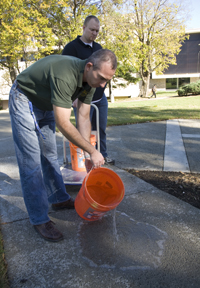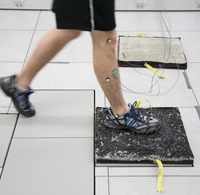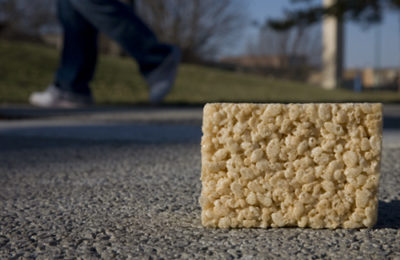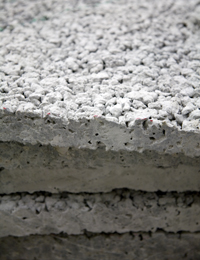Pervious concrete reduces ice-related falls, offers undergrad research opportunities
From the basement of Flarsheim Hall, “chefs” measure, mix and test secret recipes that John Kevern, assistant professor of Civil and Mechanical Engineering at the School of Computing and Engineering (SCE) likens to a popular rice cereal and marshmallow treat. But instead of satisfying a sweet tooth, these recipes for pervious concrete are reducing ice-related falls, creating undergraduate research opportunities and improving the environment.
Unlike traditional concrete, pervious concrete contains little or no sand and features craters that capture rainwater, allowing it to seep gradually into the ground and reduce stormwater run-off. Building upon this knowledge, Kevern is conducting several nationally-funded research projects and introducing the technology to students, Campus Facilities Management (CFM) and the campus as a whole.
Finding the perfect recipe

Assistant Professor John Kevern and Chris Farney, a Civil Engineering graduate student, perform an infiltration test for water absorbency.
It all starts in Flarsheim Hall’s Civil Engineering Material Mixing Lab. Fog emanates from the corner of the room, providing the humidity required for pervious concrete mixing. At lab tables, students and professors mix carefully-measured amounts of water and cement to create a paste that forms a thick coating around aggregate particles.
Next door, in the Material Testing Lab, Chris Farney, a Civil Engineering graduate student, places concrete cylinders in a compression test machine to test how much force it takes to split different types of pervious concrete.
“On average, it takes 15,000 to 20,000 pounds of force to break pervious concrete,” said Farney, who is writing his master’s thesis on pervious concrete coated with a proprietary super-absorbent polymer. “There’s direct compression – the weight. And then there’s splitting – what is the concrete’s ability to take the tension of a turning car?”
In early October, within an hour of mixing concrete, SCE and CFM poured a pervious concrete sidewalk east of Miller Nichols Library. The sidewalk functions as a walkway to CFM’s new recycling kiosk and as a test site for 14 types of pervious concrete. For example, one square is plain pervious concrete, another is coated with a super-absorbent polymer and another is coated with soybean oil.
To protect the fresh concrete from the elements, SCE and CFM covered it with a plastic sheet. After seven days, they removed the plastic and conducted infiltration tests to measure the water absorbency rate.
Reducing ice-related falls

In the Human Motion Laboratory, students measure how a person’s movements differ when walking on pervious concrete and plain concrete.
Back at Flarsheim Hall, students and professors conduct freeze-thaw resistance tests using a stainless steel freeze-thaw tank. Based on previous field research, pervious concrete’s rapid draining characteristics prevent concrete saturation from occurring.
This lack of saturation could reduce the number of falls in icy weather. That’s the basis of a National Science Foundation-funded research project led by Kevern and Gregory King, assistant professor of Civil and Mechanical Engineering.
As part of this project, students and professors conduct research in Flarsheim Hall’s Human Motion Laboratory. Outfitted with reflective body markers and electromyography (EMG) sensors, Kyle Dunning – a junior Civil Engineering student – walks across a plain concrete square, a pervious concrete square and two metal force plates. Cameras record his movements, which are projected onto a computer screen. Then, Adam Bruetsch – a first-year graduate student in Mechanical Engineering – interprets this data to measure how a person’s movements differ when walking on pervious concrete or plain concrete.
Improving the environment
In addition to reducing stormwater run-off, pervious concrete offers other environmental benefits.
Reducing the Urban heat island effect: As principal investigator of an RMC Research and Education Foundation-funded project, Kevern is researching how pervious concrete could reduce what is known as the urban heat island (UHI) effect. The UHI occurs when typical concretes, because of their bulk mass and heat absorption capacities, cause downtown areas to be as many as 22-degrees warmer than nearby rural areas. In contrast, pervious concrete has a porous nature that allows water to cool the ground.
Improving durability of environmentally-friendly products: While the sustainability movement requires the use of more environmentally-friendly products, it also calls for improvements in the durability of the built environment. Through projects funded by the C2Product through Indiana INVEST, UMKC and the University of Missouri Research Board, Kevern is studying the use of soybean oil for concrete curing. A common problem with concrete containing high levels of recycled material is that it demonstrates poor surface durability when subjected to deicer salts.
Listen to Assistant Professor Greg King talk about winter hazards and the safety advantages of pervious concrete on “Building Kansas City” – Associate Professor Deb O’Bannon’s show on KCMO Talk Radio 710.


